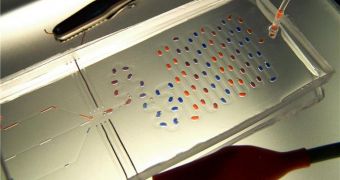In an advancement that is bound to have numerous positive outcomes, researchers in Poland recently managed to develop a new, credit card-sized microflow system. The tool allows scientists to combine a number of chemicals in a single solution. It carries a host of channels, in which drops of liquid containing various substances can navigate until they combine with each other. The instrument could help investigators carry out thousands of chemical reactions daily, virtually anywhere. The Polish team eliminated the need for a massive lab with many workbenches, AlphaGalileo reports.
The innovative mechanism was created by the Institute of Physical Chemistry of the Polish Academy of Sciences (IPC PAS). Experts here, led by DSc Piotr Garstecki, say that the effectiveness of the new tool has already been tested in antibiotics mixtures, and that their invention passed the assessment with flying colors. One of the main things scientists can do with the credit card-sized device is to produce and precisely control concentrations of reaction micromixtures.
The technique is considerably faster than microtitre plate method that most research laboratories currently use. It also operates with smaller volumes of chemical liquids, a feat which is bound to increase its attractiveness with the scientific community even more. “The device developed by us will allow even tens of thousands of biochemical experiments to be conducted daily,” Garstecki says, adding that the medical diagnostics, chemical synthesis and advancements in biotechnologies will become easier than ever with the microflow system. The contraption is in fact nothing less than a miniature chemical reactor.
“Miniaturization of everything is simply not economical. Taking the valves outside the micro-system, the chip itself can be made simple, cheap and disposable. The most important thing is that the chemical reactions themselves proceed in a microscale under precisely controlled conditions,” says PhD student Krzysztof Churski. He reveals that the system can be tuned in such a manner that up to three chemical reactions become possible each second. “Our microflow system not only reduce all costs but also significantly shortens the time necessary to conduct research,” Garstecki concludes.

 14 DAY TRIAL //
14 DAY TRIAL //